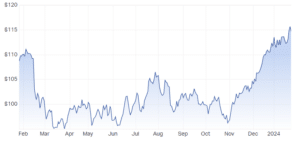Should I buy CBA shares? Or is it too late at $120 per share – an all time high

Should I buy CBA shares? CBA (Commonwealth Bank of Australia (ASX: CBA)) keeps hitting new highs, surpassing $120 per share in mid-May 2024. On a market capitalisation basis, it is worth $200bn. No other big bank comes close and the only bigger company is BHP (ASX:BHP).
You could argue CBA shares are overvalued just because of the price. It is valued at over 3x P/B, has a share price of over $120 and a market cap of $200bn (both ahead of all of the other big banks) and its bottom line is expected by analysts. On the other hand, it is a high dividend payer and is facing a positive outlook (hint: a reinvigorated property market where it is a heavy player).
Should I buy CBA shares? The key argument in favour … the housing market
CBA shares have climbed by over 23% in 12 months. It is easy to forget that the climb only began in November 2023. This was no coincidence, it occured with the bank’s release of its 2024 economic outlook, particularly focusing on the property market predictions for the new year. Senior economist Belinda Allen predicted a moderated housing market in the year’s first half, followed by a rebound post-interest rate cuts anticipated in September.
Now, economists and analysts are more pessimistic as to when they will happen. But despite the delay, things are far from doom and gloom. There is a strong demand for housing driven by an estimated 2.3% final population growth coupled with a housing shortage fueled property prices. The continuation of this supply-demand dynamic is likely to continue for the rest of 2024, albeit with less intensity, leading to a projected 5% lift in home prices across the 8 capital cities.
CBA is the biggest player out there
CBA’s position as Australia’s biggest mortgage lender means the strength of the property market directly impacts its share performance. The bank reported a significant increase in home loans, totaling $577 billion as of 30 June FY23, up from $562 billion in December 2022.
The majority of these loans are on a variable rate, which has seen a rise over the past year. Despite an increase in borrowers experiencing negative equity and mortgagee-in-possession loans, CBA’s strong market position (over 20% and one of the top 2 players) and increasing home loan portfolio present a positive outlook for the bank’s future performance. Oh, did we forget to mention that CBA has a lower portion of its book as mortgage-broker initiated loans? This is good because CBA does not have to pay as much upfront and trailing commissions than its peers – both of which are eating into the NIM of other banks.

CBA share price since early 2023
So far so good
The two financial updates thus far this calendar year have done little to dent investor optimism. CBA unveiled its 1HY24 results in February, recording a profit of $4.8bn on a statutory basis and an NIM of 1.99%. These were down 8% and 11 basis points respectively on 1HY24. However, the bank managed to increase its dividend by 2% to $2.15, which was over 70% of its cash profit. The bank closed the period with a 12.3% CET1 capital ratio, well ahead of APRA requirements. The takeaway from these results was that even though the market was competitive, the company was managing to keep its head above water, still being the most profitable bank. The fear that the bank would see en-masse defaults due to higher interest rates did not eventuate – bad debt actually decreased by $96m year on year.
Looking forward to May, the company delivered a trading update. Its unaudited profit was $2.4bn, down 5% quarter on quarter. But it still retained a 11.9% CET1 ratio. The bank’s income was flat compared to the prior quarter as was net interest income. Although deposits grew and home loans were growing lower than the broader system (at 0.7x the system), the mix of home loans without brokers was 65% of new business flows.
Should I buy CBA shares? The arguments against it … CBA’s Net Interest Margin
As good as the bank is and CBA shares may look as a consequence, challenges such as increased competition and pressure on the net interest margin (NIM) cannot be overlooked, even if you ultimately decide to invest in it.
The company’s 20x P/E ratio does not look too unreasonable, although its P/B of 3x suggests a cautious approach to investing in CBA shares at the current valuation. Maybe you get what you pay for, but consider that any PEG multiple over 1x suggests an overvalued company.
CBA’s NIM did not move up as much as it did even with rising interest rates, and it will be squeezed if and when interest rates fall.
Looking to dividends, there’s no shying away from the fact that it usually pays the highest dividend per share. That may be enough for some investors. 12 million super fund members received a combined $2.4bn in earnings on their CBA shares for FY23. And that does not even account for Australians who hold CBA shares in their own right, outside their super fund. Those people received an average dividend of $3532. Nonetheless, it is far from the highest yielding big bank stock, even if this just because of its higher share price – in fact, it was the lowest in FY23.
The Takeaway for Investors
The only investors who will see little to no downside from buying CBA shares is those who invest seeking the highest possible dividend payouts. Those looking for yield will be better off in other big bank stocks.
Looking at the business’ fundamentals paints a mixed picture. While CBA’s strengths in ROE, dividend history, and business growth make it an attractive investment, the current high valuation and competitive landscape in the lending sector necessitate a cautious approach. Growth or value investors considering CBA shares should weigh these factors, alongside the bank’s proven track record and strategic growth initiatives, to make an informed decision.
What are the Best ASX Banking Stocks to invest in?
Check our buy/sell tips
Frequently Asked Questions
- What is the predicted share price of CBA in 2025?
Predictions for CBA’s share price in 2025 range from AUD 123.90 to AUD 137.20, influenced by economic conditions, interest rates, and market competition.
- What factors could influence CBA’s share price in 2025?
Key factors include economic conditions, interest rate fluctuations, regulatory changes, market competition, and CBA’s operational performance.
- Is it a good time to buy CBA shares now?
It depends on your investment goals. CBA is attractive for dividend seekers but may be less appealing for value investors due to its high current price. Consider market volatility and economic changes.
- What are the potential benefits of investing in CBA shares?
Benefits include stable dividends, CBA’s strong market position, and consistent revenue growth. These factors make CBA a solid choice for income-focused investors.
- What are the potential risks of investing in CBA shares?
Risks involve market volatility, interest rate fluctuations, and potential regulatory changes affecting profitability and operations.
Blog Categories
Get Our Top 5 ASX Stocks for FY26
Recent Posts
Develop Global Wins $200m OceanaGold Contract- What It Means for Investors
Develop Global (ASX: DVP) climbed 4% to A$4.36 on Friday after securing a A$200 million underground development contract with global…
Nova Minerals Drops 14% on $20m Capital Raise- Buy or Avoid?
Nova Minerals (ASX: NVA) dropped nearly 14 per cent to A$0.90 following the announcement of a US$20 million (approximately AUD…
WiseTech (ASX:WTC) Rises After Richard White Cleared of Misconduct – Should You Buy the Dip?
WiseTech Global (ASX: WTC) climbed 3 per cent to A$70.18 on Friday after founder and Executive Chairman Richard White was…



